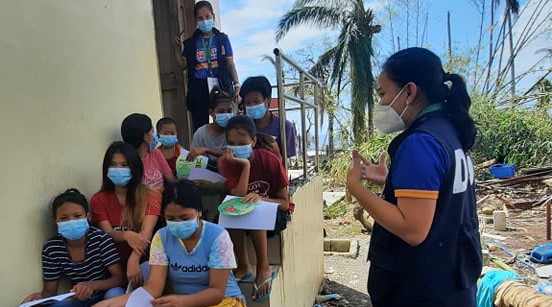PALO, Leyte — Reminders of the catastrophe that happened almost nine years ago are almost gone except for a few structures abandoned by their owners for being beyond repair or for harboring bitter memories.
In Baras village, one of the coastal communities most devasted by typhoon “Yolanda,” 53-year-old Vilma Cobacha, a barangay health worker, attended to her patients, mostly mothers needing prenatal and postpartum care.
Behind her enthusiasm and zest, however, lies a deep trauma that, she said, she has been trying hard to cope with, but without much success. A great fear resurfaces in her every time a storm howls back into her consciousness, she told Daily Tribune.
“A mere mention of an incoming typhoon already scares me. When the typhoon is here, I keep trembling and is unable to sleep the whole night,” she continued. “People here have already developed a phobia for typhoons.”
Cobacha recalled that almost 100 residents of Barangay Baras perished during typhoon “Yolanda,” said to be the strongest typhoon that ever made landfall in the country in modern history. All five members of the Cobacha family survived.
Government records have shown that some 6,000 people were killed during “Yolanda,” a conservative estimate as over 10,000 were believed to have died in Leyte alone.
“It’s been so long but I still remember the dead bodies that were scattered everywhere. I met a woman who was carrying a dead child in her arms. It was both painful and a poignant sight,” she recounted.
Lyn Abella, on the other hand, was preparing her 11-year-old son for his afternoon class when thick dark clouds blanketed the horizon. A few minutes later, thunder and lightning sent her into a panic, crying under a blanket in the corner of the house she sought refuge from against the noise and cascading memories.
Happenstance? Maybe. But the thunderstorm ended the interview.
“Typhoon ‘Yolanda’ left something within her, some kind of a demon that keeps on haunting her. I pity her but what can we do? We don’t know until when she will be living in this fear,” Lyn’s mother tells Daily Tribune.
The Abellas were living in a coastal community when “Yolanda” struck on 8 November 2013. The night before the typhoon made landfall, her family sought refuge in a nearby school.
But during the night, they realized that the infant formula was left in the house, prompting her husband to return home early in the morning to get it, right at the time when a storm surge and strong wind came. She never saw him again.
Her mother said Lyn roamed the city for more than two weeks with her two children searching for her husband. A neighbor saw Lyn downtown with her two children — one in her arms and one in tow — and immediately informed the family.
“We found her after two days. She looked dazed and miserable as if she just came from a war. My three-year-old grandson was barefooted and looked very tired as they have not slept well for days,” she said.
Her mother brought Lyn and the two children home to their house far away from the coastal village where they now live.
“At first she was always distressed but later she started acting normal except when there is a typhoon or there is heavy rain,” she said.
The mother brought Lyn to a tambalan or traditional healer who smoked her with incense to ease her mind. It did not work.
Problems persist
Almost a decade since “Yolanda” struck, many people are still living with the trauma that the super typhoon brought them.
Some are still in deferred or extended mourning mode as the bodies of their loved ones have remained missing.
The Department of Health regional office here does not have data on the number of people who are experiencing mental health issues caused by “Yolanda.” But randomly asking around, many would point to a relative, a friend or a neighbor who are still traumatized by the perfect storm.
Winnie Dorego, regional mental health manager at the DoH office in Eastern Visayas, says it is difficult to quantify the number of people experiencing mental health issues.
“We cannot say that when a person has already been treated, he will no longer have a mental health problem. There are many factors that affect the wellbeing of a person such as the environment,” she said.
She explained that the DoH relies on the provincial, city and municipal coordinators on mental health to provide them with an annual report on the number of mental health patients in their respective locality.
Eastern Visayas has three facilities that receive mental health referrals from the local government units — Eastern Visayas Medical Center (Tacloban City), Schistosomiasis Hospital (Palo, Leyte) and Treatment and Rehabilitation Center (Dulag, Leyte) — which are all run by DoH.
Dorego said that from January to December 2021, Schistosomiasis Hospital conducted 932 outpatient consultations while EVMC had 7,718 or an average of 30 consultations a day. DoH-TRC accepts referrals for drug-related mental health cases.
The figures, however, do not tell the number of individuals that have consulted a psychiatrist since some are repeat consultations or are on a follow-up checkup.
“This is a quite high number considering also the number of psychiatrists that we have,” Dorego said.
According to Dorego, there are presently only eight active psychiatrists in the whole Eastern Visayas — six are based in Leyte, one in Samar and one in Northern Samar — serving the region that has 4,547,150 inhabitants based on the 2020 Census.
Three of the six provinces in Eastern Visayas — Eastern Samar, Southern Leyte and Biliran — are without a consultant psychiatrist thus patients have to be brought usually to Tacloban City for a checkup.
“We have very few psychiatrists so this makes mhGAP very important,” Dorego said.
To be continued
(This story is part of the journalism fellowship of the Philippine Press Institute under the auspices of the Hanns Seidel Foundation.)
